If you have ever looked at the specifications of Nvidia and AMD Graphics cards then you must have seen the terms CUDA Cores and Stream Processors listed there. Both these terms are the same in some respect but they are also quite different if you go into the core technical aspect.
CUDA Cores and Stream Processors are one of the most important parts of the GPU and they decide how much power your GPU has. Here in this post, I am going to explain CUDA Cores and Stream Processors in very simple words and also list down the various graphics cards that support them.
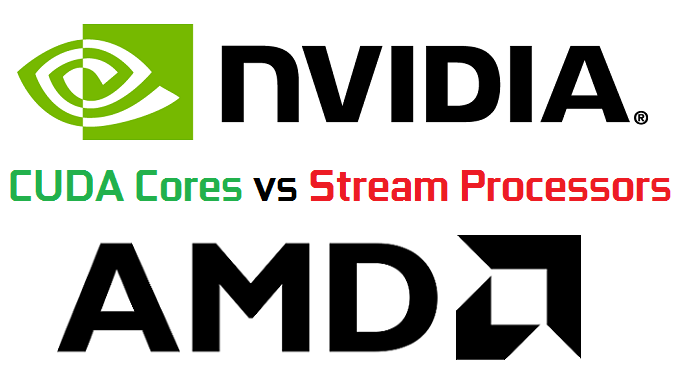
What are CUDA Cores & Stream Processors?
CUDA Cores & Stream Processors are also called processor cores or pixel pipelines of a GPU. You have already heard about multi-core processors such as dual-core processors, quad-core processors, Hexa-core processors, and octa-core processors in computers and mobile phones. These multi-core processors consist of very few cores that perform various individual tasks and increase parallel processing and multi-tasking. This ultimately leads to better performance and efficiency.
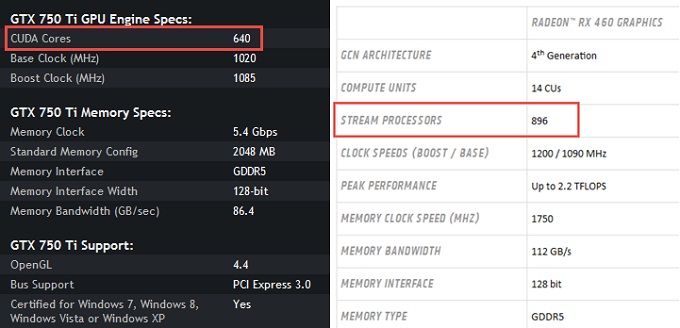
Similarly, a GPU or Graphics Processing Unit is made up of hundreds and thousands of cores that perform various complex operations and computations related to pixels (pixel processing). These Cores are known as CUDA Cores or Stream Processors. NVIDIA calls them CUDA Cores and in AMD they are known as Stream Processors. Generally, these Pixel Pipelines or Pixel processors denote the GPU power. The more is the number of these cores the more powerful will be the card, given that both the cards have the same GPU Architecture. Both CUDA Cores & Stream Processors have the almost same use in graphics cards from Nvidia and AMD but technically they are different. This is because of the difference in the GPU Architecture of both Nvidia and AMD graphics cards.
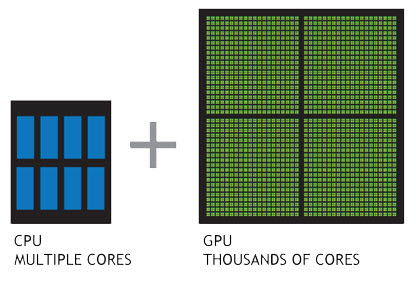
CUDA (Compute Unified Device Architecture) is mainly a parallel computing platform and application programming interface (API) model by Nvidia. It accesses the GPU hardware instruction set and other parallel computing elements. The physical individual cores inside the GPU that execute CUDA API are known as CUDA Cores. Graphics cards having Tesla, Fermi, Kepler, Maxwell, Pascal, and Volta GPU architectures supports CUDA.
Must Read: Important Technical Terms related to Graphics Cards
What are Tensor Cores?
Volta GPU architecture-based graphics card Nvidia Titan V comes with Tensor Cores (640 tensor cores) in addition to CUDA Cores. These Tensor Cores help in AI, Deep Learning / Machine Learning and can deliver around 110 TeraFLOPS (TFLOPS) of performance. This is over a 5X performance increase over the older Pascal GPU architecture from Nvidia. Tensor Cores are responsible for evaluating large complex mathematical problems and computations. Nvidia Titan V graphics cards also come with 12GB HBM2 memory which is currently one of the fastest memory around.
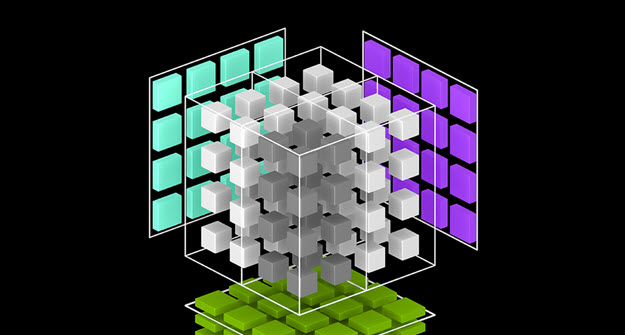
Note: Pascal GPU architecture does not support Tensor Cores.
CUDA Cores vs. Stream Processors
It must be noted that CUDA Cores are not equivalent to Stream Processors in terms of power and number. That means two graphics cards having the same number of CUDA Cores, Stream Processors, Memory, and Clock Frequencies cannot have the same performance. This is again due to the difference in the working of the GPU architecture of the graphics cards. If we have two 10 series Graphics cards G1 and G2 with the same memory and clock from Nvidia having 380 and 480 CUDA Cores then G2 will be more powerful because of the extra 100 CUDA Cores.
So,
G2 > G1*
*in terms of performance given that both cards are in the same family or have the same GPU architecture.
So, if the CUDA Cores of one graphics card are more than the other graphics card given that both graphics cards are in the same family then the graphics card with a higher number of CUDA Cores will be more powerful.
How many Stream Processors equals CUDA Cores?
If we have an Nvidia Graphics card with 500 CUDA Cores and an AMD Graphics Card with 600 Stream Processors then we cannot conclude that AMD Graphics Card is more powerful. Here to find out which graphics card is more powerful we have put them to real-world gaming benchmarks. The card that scores more frame rates or fps in games will be the winner.
So,
X no. of CUDA Cores ≠ X no. of Stream Processors
Some Important Points to Remember
- CUDA Cores are Nvidia’s GPU Multi-core units
- Stream Processors are AMD’s GPU Multi-core units
- We cannot equate CUDA Cores and Stream Processors
- GPU Architecture matters a lot along with the number of GPU Cores
Final Words
At last, I would like to say that I have tried my best to clearly explain the similarities and differences between CUDA Cores and Stream Processors. Both CUDA Cores and Stream processors are nothing but processor cores in a GPU. Their working, functions, shape, and size may differ according to the GPU architecture. If you have any queries regarding them then you can ask me by leaving a comment below.
(*This post may contain affiliate links, which means I may receive a small commission if you choose to purchase through the links I provide (at no extra cost to you). Thank you for supporting the work I put into this site!)
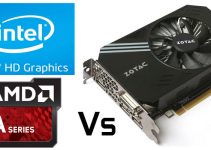

![Why does my Graphics Driver Keep Crashing? [Nvidia and AMD] Why does my Graphics Driver Keep Crashing? [Nvidia and AMD]](https://graphicscardhub.com/wp-content/uploads/2024/10/graphics-driver-keep-crashing-211x150.jpg)
example..(for same level amd n nvidia gpu)… 500 cuda core vs 500 stream prosesor.. result? who more power? which one the winner? this most important i think. cant see it in ur article. sory for bad engfish.
Hello,
I have mentioned this in my article that cuda cores can’t be equated to stream processors. So between 500 cuda cores and stream processors we can’t really say which card is more powerful as this also depends on the GPU architecture.
so it looks at the GPU architecture…?. (honestly what gpu architecture mean? is it the gpu hardware build? ) so..which one the better..? at ur example gtx 750ti vs rx 460 both at the same price.. we count for famous game like dota 2..witcher..doom.. i want to know which 1 card i should buy..? sory for make this isu. really thank ur help.
GPU architecture governs the working of a GPU including cuda cores & stream processors. It is the main factor when considering the performance of a graphics card. You can learn more about it here https://graphicscardhub.com/nvidia-pascal-vs-amd-polaris-gpu-architecture/. Also it is difficult to compare the GPU architecture of graphics cards from different companies i.e. Nvidia and AMD because of their completely different technologies. Between gtx 750 ti and rx 460, RX 460 is the more powerful one and is a newer card.
sory for late reply.. as u say..nvidia and amd..completely different technologies..so if we did’t look at the gpu model (nvidia n amd) base on ur opinion…for 2017 gpu.. which company has use the best technology..? for example (this is not about GPU but i think its.. similar) i talk.. about CPU.. as i know..amd has put many core then intel…in their cpu, but intel prosesor..has a better technology..(sory if iam wrong).. so…back to the GPU.. is it the same thing happen to amd n nvidia..? which company has use the better technologies.. today?
Well technologies change with time but for now Nvidia has better and powerful graphics cards based on their Pascal GPU architecture. Also they has lower power consumption compared to similar AMD cards.
HI how does it compare macpro afterburner to the more powerful available card in a maxed dell ? Where do you get more power?
Did not get you. Please explain!
ok more clear now.. i will learn about that pascal..thanks alot..Akshat Verma.. hope u will be more success in future..
Thanks for your kind words and please share this blog with your friends. Also if you have any more queries then feel free to ask.
i will..
Thanks a lot.
welcome
Good Article ! simple and to the point !
Thanks for your nice explanation. Can you please explain if I have 336 CUDA Cores in GTX 560 and 896 Stream Processor in R7 260X, which one will perform better? I’m gonna buy a GTX 560 which has 336 CUDA Cores. Comparing to AMD’s Stream Processor how well 336 CUDA Cores will perform?
Thanks in advance…
As i have already explained that there is no direct relation between CUDA Cores and Stream Processors, but here Radeon R7 260X is a bit better than GTX 560.
Thanks for your reply. Anyway my budget is tight. Going for GTX 560.
is Tensor cores only be able to use for deep learning? how about graphic rendering?
Yes Tensor cores is only for AI / Deep Learning. For other work, there are CUDA Cores.
I’m still confused. From my understanding Cuda cores seems more straight forward where as stream cores is confusing. I’m looking to use say da vinci desolve editor with an amd gpu but don’t know which one to pick based on stream cores.
You should have a look at the Radeon RX 5700 or Radeon RX 5700 XT.
Thank you for the article, it did teach me exactly what the difference in CUDA cores and Steam Proc/ors is!
Man, if we have an Nvidia card (no name) with 1500 CUDA cores and an AMD card (no name) with 1900 stream processors you will see that AMD card performs better than the Nvidia card in benchmarks. Hence we can conclude that Cuda cores and Stream Processors could be considered for comparison purposes regarding the power of the card. In other words they do the same thing but have different names. You will also notice that cards with more Cuda Cores or more Stream Processors have also better Base Clock and higher VRAM that also contributes to the speed and power of the card because they are all interconnected. You can’t build one without the other and so on. Conclusion, yes you can compare an Nvidia Card with an AMD card based on Cuda Cores and Stream Processors because all the other specs fall in place anyway.
Could be in some cases.
I would like to add an important detail to what I stated above. Cuda cores and Stream Processors could be used for comparison purposes only if the core clock, vram size and technology (gddr5, 6 and so on) of both cards is the same. Otherwise the results are really tricky. Unfortunately we can’t find too many GPUs to have the same core clock and vram technology from these big brands hence the confusion among the users when they try to compare them. But I really get what you were trying to explain in your article, and you are right about it. By the way, very good article.
Thanks for your input on this subject.
Stream processors are single-function execution cores found within an AMD graphics-processing unit (GPU). Thousands of stream processors on each AMD GPU can run the same function of a large data set for high computation through ultimate parallel processing. This type of parallelism is called Single Instruction Multiple Data (SIMD). AMD stream processors are similar to NVIDIA’s CUDA cores, but have a primary difference in their respective architecture. CUDA cores have the ability to process separate functions at the same time and each core can function independently. This type of computational parallelism is called Multiple Instruction Multiple Data (MIMD).
Thanks for the info & explanation, very instructive.
for some reason – referring to some architecture there you think cuda is not equal to steam. I get that. but it would have been better to include “why” is that? e.g in User benchmark site GTX 1650 super more ratings than RX 570. But RX 570 has double steam processors than 1650’s cuda cores. Still why it has low ratings is now a confusion after reading this article.
You can’t equate CUDA Cores to Stream Processors. GTX 1650 SUPER has superior architecture and platform compared to RX 570.
Which would be better for machine learning amd or nvedia
Nvidia RTX series cards.
If Steam Processors and Cuda Cores can’t be compared this article is useless for someone who wants to compare Nvidia vs. AMD. So clearly, to answer Anonymous, you must tell him what he has to lookt at so that he can make his comparision. Just stating Cuda Cores and Steaming processors can’t be compared leaves him without a solution. So give him the solutions please. How can he make a comparision. What does has to look at?
The only way to compare Nvidia and AMD cards is by looking at their benchmarks both synthetic and real word.
It’s relevant to point out that things have changed since DirectX 11 Engines are no longer in the development cycle. NVIDIA milked DirectX 11 for awhile because it’s an API designed to mainly take advantage of NVIDIAs cores. That’s not the case anymore now that DirectX 12 is present and isn’t just some ghetto patch in DirectX 11 to enable Ray Tracing for NVIDIA. The full DirectX 12 API has proven to give AMD the edge in pure shader core power and efficiency so when to state “real-world” benchmarks, are you referring to irrelevant benchmarks from games under the DX11 API? There is a reason why even AMDs older GCN cards suddenly started catching up with NVIDIA s cards in games like Horizon Zero Dawn and Death Stranding.